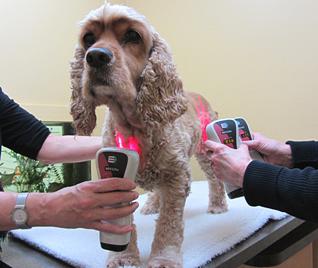Treating Cancer with Laser
Archive ∙ Back to Island Voices
July 2014
We are doing research on the use of the laser, and there are so many things it can help. Here is an excerpt of a paper we recently published in the Journal of the American Veterinary Medical Association.
Click on: http://www.healinglaserforpets.com/
And look for the button “published research”

Case Report 1: Retroperitoneal Mass: Soft Tissue Sarcoma
A nine year old, castrated male Labradoodle was presented for a general examination following an unusual episode of aggression towards another dog. He exhibited sensitivity with palpation of the epaxial muscles of the lumbar spine, but more importantly, a mass was detected in his caudal dorsal abdomen. The mass could not be palpated rectally on this initial exam.
On ultrasound examination, a 13x4x7cm infiltrative mass was found in the caudal retroperitoneal space. The mass was closely associated with the aorta, vena cava, and the internal and external iliac arteries. Based on the location, size, and infiltrative nature of the mass, a retroperitoneal sarcoma (nerve root tumor, spindle call sarcoma, fibrosarcoma) was most strongly suspected. No measureable evidence of metastasis was seen in the abdomen, but thoracic radiographs were not performed.
Surgical removal was considered an unfavorable option due to the involvement of the blood vessels. The owner decided to use FSLLLT for palliative care for the tumor and to manage the dog’s back pain rather then pursue chemotherapy for the tumor alone. Based on this decision, getting a definitive diagnosis with a needle aspiration was declined. The laser frequencies were chosen in attempts to address both the tumor as well as the musculoskeletal pain.
An intensive therapy schedule was instituted. The patient was lasered twice daily for three days, daily for four days, then twice weekly. After 18 days and 12 sessions, the patient was quite active and moving well, indicating that his pain was greatly diminished. On abdominal palpation, the mass was felt to have grown, but with the benefit seen with the musculoskeletal pain, the owner decided to continue treatment. The frequencies for orthopedic pain were removed but those for the sarcoma were continued.
By day 45, the patient was running six kilometers with the owner and had a great appetite. On day 68, the dog deteriorated (19th treatment). Once again, he had heat and discomfort in his lumbar area. Frequencies to relieve the inflammation in the spine were added to his frequency set. When the dog presented again three weeks later, his signs were much improved. Frequencies for pain were periodically used throughout the course of treatment to keep his spine comfortable.
The laser therapy was continued on roughly a monthly basis. The 25th treatment was done on day 166. The mass felt the same size as it did when it was first detected. On day 178, the mass size was noted to be stable. The patient was not treated again until day 298. At that time, the mass was not palpably enlarged, but the surface was more irregular in texture.
Over the next 12-week period, the patient received additional FSLLLT (with appropriate light frequencies) that addressed other medical conditions – an anal sac abscess and two bouts of ileocolitis.
As well, a new CCF frequency (for liver tissue) was added. Until that time, the frequencies provided by Inman for sarcomas had been employed – those for bladder and skin. On day 325, the mass was significantly smaller on abdominal palpation and it was smaller yet again when it was felt on day 352 (31st treatment).
The patient was reassessed on day 449 because he started having difficulty defecating. The mass was much larger, irregular, and had invaded the entire pelvic canal, restricting stool passage. He received his 36th treatment that day.
A stool softener was introduced (Peg 3350 1 teaspoon q 12 h or to effect) (d) to allow easier passage of the feces. The laser sessions were increased to three times that week and twice weekly for a further three weeks. After one session, the patient was more comfortable but still straining. By day 459, he was not straining; he was passing stools of varying sizes (still on the stool softener).
On day 466, the mass in the abdominal cavity had shrunk noticeably by abdominal palpation. It was even smaller on day 491. When assessed on day 544, the mass was stable in size.
On day 552, the patient was presented because he was unable to urinate. The abdominal component of the mass had once again grown significantly. A catheter could be passed, but the dog could not urinate unassisted. He was lasered that day and he subsequently managed to urinate on his own for two days. Reobstruction occurred on day 555, at which time euthanasia was elected by the owner.


